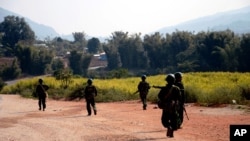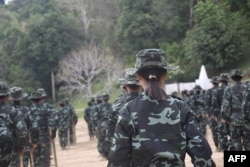As rebel forces across Myanmar continue making major gains against the country’s military regime on the battlefield, resistance groups are working behind the scenes to plan for the government they want to take the junta’s place.
It is not clear that the effort will succeed, and if it does not, some analysts fear a political vacuum if the junta-led government should fall.
At a so-called People’s Assembly in January 2022, nearly a year after the military seized power, upwards of two dozen resistance groups endorsed a two-part charter laying out their vision for a new order that would loosely bind Myanmar’s states together as a democratic and federal — or “union” — government.
Since then, though, they have been struggling to agree on just what a federal union should look like and how to build it, analysts following the talks tell VOA.
“What has propelled them thus far is this least common denominator that everyone buys into: a federal democratic system,” Zachary Abuza, a professor at the National War College in Washington told VOA in recent days.
“But once you actually get down to brass tacks and try to define what that is, everyone all of a sudden gets cold feet and doesn’t want to attach their names. I think everyone is still kind of waiting this out, seeing what else they can get,” he said.
Some of Myanmar’s states are home to large ethnic minority populations, which together account for roughly a third of the country’s 54 million people. Rebel armies among the minorities, dubbed ethnic armed organizations, or EAOs, have been fighting Myanmar’s ethnic Burman-dominated military for control of parts of those states for decades. They have been demanding a federal union that gives their states more autonomy for just as long.
The new charter is a bid to answer their call, but it remains vague on how the federal and state governments would share power in a new Myanmar.
The charter calls the states “the original owners of sovereignty” and says the union “shall consist of member states which have full rights to democracy, equality and self-determination.” It adds that the specific powers of the union and of the states “shall be determined,” without elaborating.
Where the power lies
Among the EAOs, debate over the charter has mostly focused on how much power each state may want to grant the union or keep for itself, said Ying Lao of the Salween Institute for Public Policy, a Myanmar think tank.
Another key player in the talks is the so-called National Unity Government, an alliance of civilian resistance groups including some of the mostly Burman lawmakers ousted by the 2021 coup. Disputes over the charter between the EAOs and NUG are deeper and “ideological,” Ying Lao said, about where political power in Myanmar actually lies.
As the EAOs see it, she said, that power rests with the states, and the union “has only the powers that they are willing to share with the union. That’s the kind of federalism they are looking for. But for the Bamar [Burman] political elite, they claim that sovereignty rests with the country, which is the union of Burma, and that the states have the powers that the union is willing to share with them.”
That dispute is echoed in the concerns some groups have with the charter’s second half, or Part 2, which lays out a rough roadmap for shifting to the full-fledged federal union envisioned in Part 1. It says the lawmakers ousted by the coup would serve as an interim legislature and sets no time limit.
Analysts tell VOA that minority groups say that hews too closely to the centralized, Burman-dominated government they have been struggling for decades to replace. When it came time to endorse that part of the charter at the 2022 People’s Congress, they said, some of the groups that endorsed Part 1 abstained.
In the final days of a second People’s Congress held earlier this month for resistance groups to keep planning for a future government, the NUG and ousted lawmakers pulled out. They claimed the event had gotten out of hand and that the issues some of the groups were raising were out of bounds.
The NUG includes ethnic minority officers and takes pains to stress its inclusive credentials. Ying Lao said its actions, however, are reinforcing the impression among some that Burman elites still dominate.
Many minority groups feel a faction of the NUG “still has this Burma-centric, or what they call a chauvinistic mindset,” Kim Jolliffe, an independent Myanmar analyst and researcher, told VOA.
“They support the [charter], but they don’t fully have trust in the process, that it’s really going to be implemented,” he said.
Less talk, more action
Many of Myanmar’s EAOs, including a few of the most powerful, are not even taking part in the charter talks, or are doing so only at arm’s length.
Some are not waiting for the details to be worked out either, and they have started building whole new governments on their own in their home states.
Armed and civilian ethnic Karenni groups in Kayah state were the first to declare an interim government replacing the military regime across their state in June. The Arakan Army EAO has been building its own government as well across the parts of Rakhine state it has battled to reclaim from the junta. Resistance groups elsewhere are following suit.
“A lot of the [EAOs], they’re saying now, we’re not going to get bound up in any more debates about the [charter], we’re just going to build our states, and we’re going to come together and then we’ll decide what needs to be shared as a union of equals,” Jolliffe said.
Working out the details “is going to be very messy,” Abuza said. He noted he also worries that both the EAOs and NUG, which has its own network of militias fighting the Myanmar military across the country, will want to concede less politically as they gain ground against the junta on the battlefield.
The junta may still be far from defeat. It continues to hold Naypyitaw, the capital, and main cities, and has the edge in funds and firepower. But the military is widely loathed and overstretched and has now lost control of most of Myanmar’s borders.
Should the junta lose or collapse before the EAOs and NUG work out their political differences, analysts like Abuza say they worry about a federal power vacuum and the problems that could cause.
Ying Lao is more sanguine. She says Myanmar has “never really existed” as a functioning union with a central government that meets the needs of its states, and it could continue to muddle along without one.
“Not getting that functioning federal union anytime soon, for the people on the ground, the situation will only get worse and worse. But whether this country will remain intact, I’m sure it will,” she said. “But no one will have any real power in the country. … It’s going to be chaotic, for sure.”
Ingyin Naing in Washington contributed to this report.










